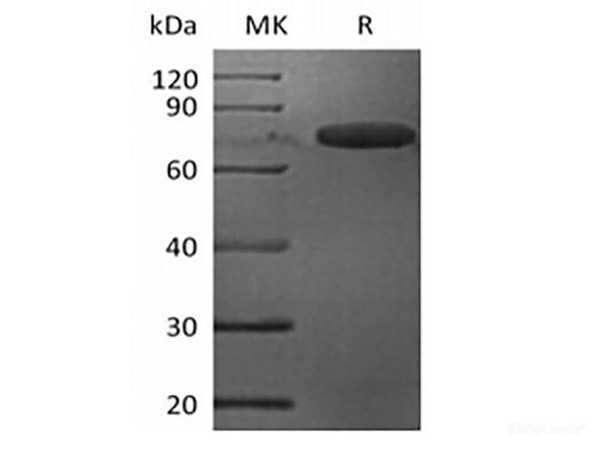Recombinant Mouse Leukocyte Ig-Like Receptor B4/LILRB4/CD85k/ILT3 (C-Fc)
- SKU:
- RPES6629
- Product Type:
- Recombinant Protein
- Species:
- Mouse
Frequently bought together:
Description
| Product Name: | Recombinant Mouse Leukocyte Ig-Like Receptor B4/LILRB4/CD85k/ILT3 (C-Fc) |
| Product Code: | RPES6629 |
| Size: | 10µg |
| Species: | Mouse |
| Expression Host: | HEK293 Cells |
| Synonyms: | Leukocyte immunoglobulin-like receptor subfamily B member 4, Mast cell surface glycoprotein Gp49B, CD85k, Lilrb4, Gp49b |
| Mol Mass: | 51 kDa |
| AP Mol Mass: | 65-85 kDa |
| Tag: | C-Fc |
| Purity: | > 95 % as determined by reducing SDS-PAGE. |
| Endotoxin Level: | < 1.0 EU per μg of the protein as determined by the LAL method. |
| Bio Activity: | Testing in progress |
| Sequence: | Gly24-Lys238 |
| Accession: | Q64281 |
| Storage: | Generally, lyophilized proteins are stable for up to 12 months when stored at -20 to -80°C. Reconstituted protein solution can be stored at 4-8°C for 2-7 days. Aliquots of reconstituted samples are stable at < -20°C for 3 months. |
| Shipping: | This product is provided as lyophilized powder which is shipped with ice packs. |
| Formulation: | Lyophilized from a 0.2 μm filtered solution of 50 mM Tris-HCl, 100mM Glycine, pH 7.5. Normally 5 % - 8 % trehalose, mannitol and 0.01% Tween80 are added as protectants before lyophilization. Please refer to the specific buffer information in the p |
| Reconstitution: | Please refer to the printed manual for detailed information. |
| Background: | Mouse Leukocyte Immunoglobulin-like Receptor Subfamily B Member 4 (LILRB4/CD85k/ILT3) is an approximately transmembrane glycoprotein that negatively regulates immune cell activation. Mouse LILRB4 consists of a 215 amino acid (aa) extracellular domain with two Ig-like domains, a 22 aa transmembrane segment, and a 75 aa cytoplasmic domain with 3 immunoreceptor tyrosine-based inhibitory motifs (ITIM). Within the ECD, mouse LILRB4 shares 45% and 77% aa sequence identity with human and rat LILRB4, respectively. Alternative splicing of mouse LILRB4 generates a potentially soluble isoform that lacks the transmembrane segment. LILRB4 is expressed on dendritic cells (DC), monocytes, macrophages, and vascular endothelial cells (EC). Ligation of LILRB4 triggers ITIM-mediated inhibition of cellactivating signaling, leading to enhanced immune tolerance and reduced allogeneic graft rejection. Soluble LILRB4 induces the differentiation of CD8+ T suppressor cells (Ts) that can inhibit the effector functions of CD4+ Th cells and CD8+ CTL. In turn, CD8+ Ts cells induce LILRB4 up-regulation and a tolerogenic phenotype in monocytes, DC, and EC. |










